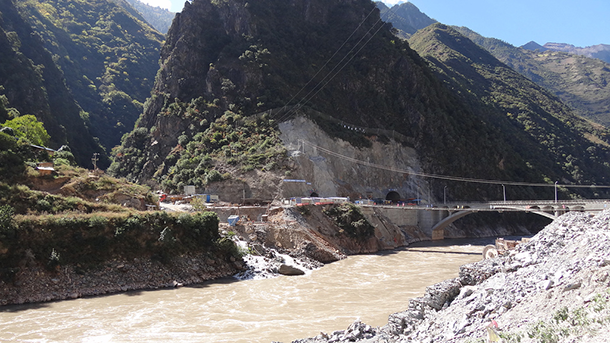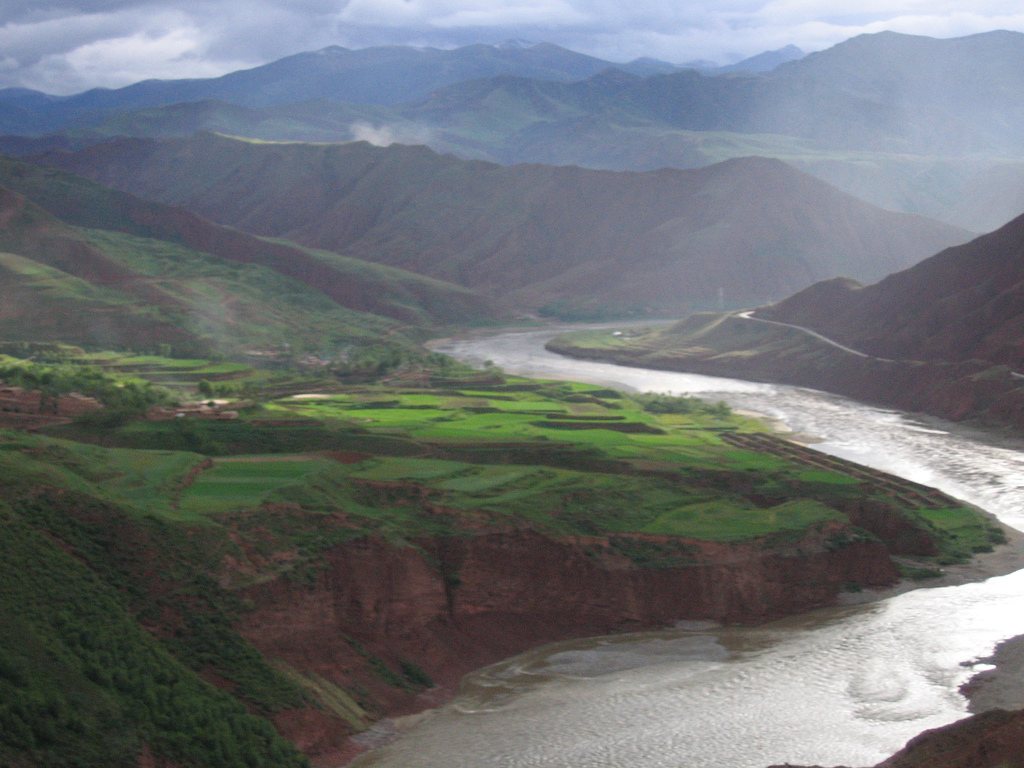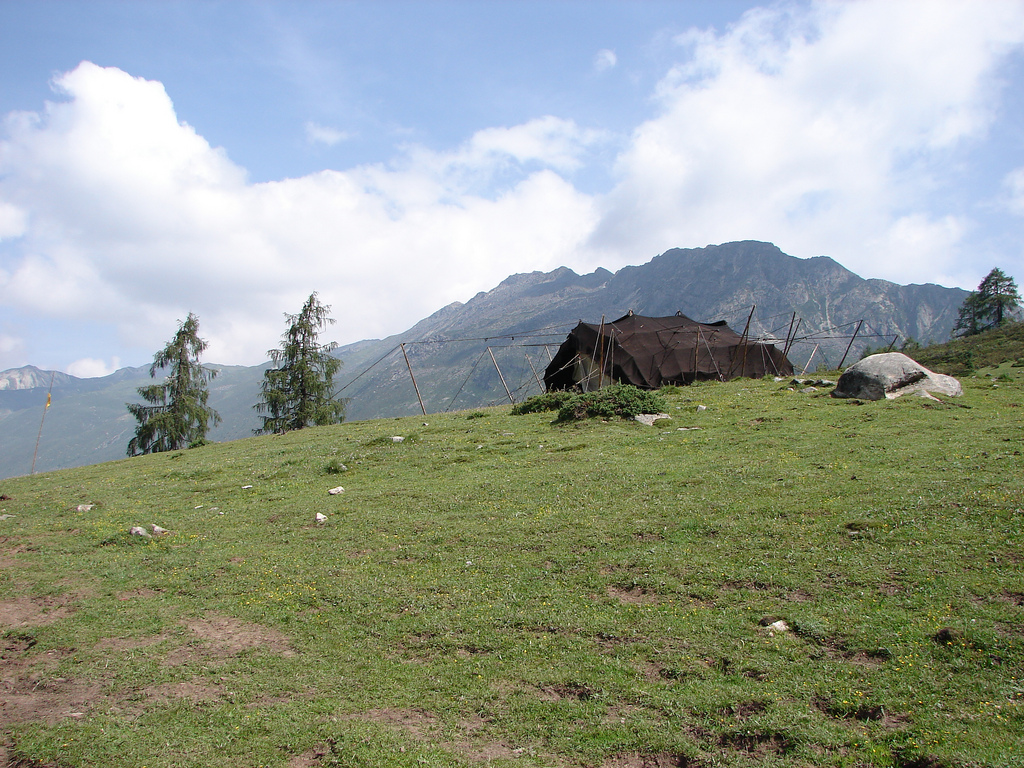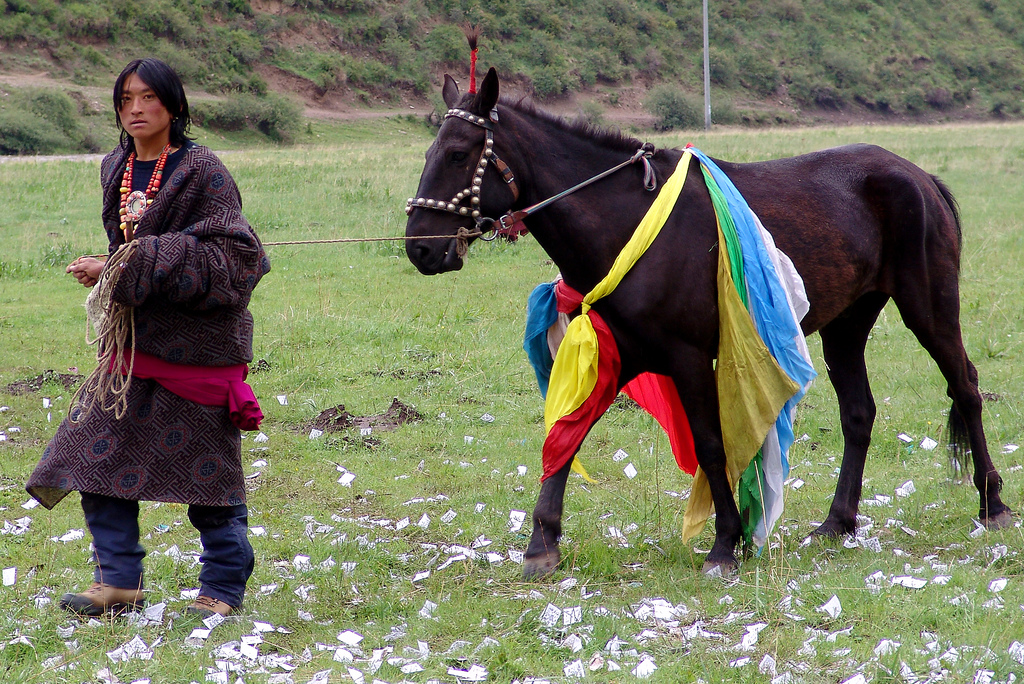Meltdown in Tibet
Air Date: Week of July 3, 2015

China’s construction of dams on the Lancang (or Upper Mekong) threatens a complex ecosystem downstream that supports over 60 million people in Southeast Asia. Five megadams have already been built, eight are underway, and several more are being planned upstream in Tibet and Qinghai. In October 2012, International Rivers went to investigate the current status of dam building on the Lancang River. The 990MW Wunonlong Dam would displace several largely Tibetan villages. Two tunnels have been built to house power stations inside the mountain. (Photo: International Rivers; Flickr CC BY-NC-SA 2.0)
The glaciers of the Tibetan plateau feed into rivers that provide water to much of the Asian continent. But now in an effort to generate power for its massive population, China has begun damming those rivers. Writer Michael Buckley talks about his book about the assault on Tibet’s natural resources with host Steve Curwood.
Transcript
CURWOOD: It's Living on Earth. I'm Steve Curwood. Only the Arctic and the Antarctic have more ice than the glacial highlands of the Tibetan Plateau, earning it the nickname ‘the third pole’. The headwaters of some of the world's most powerful rivers -- the Yangtze, the Yellow, the Brahmaputra, the Irrawaddy, the Ganges, the Mekong - flow from the high altitude plateau into Asia, providing life-giving water for drinking, agriculture, fisheries -- and recently, hydropower. That’s the subject of a book from travel writer Michael Buckley, called “Meltdown in Tibet”, which focuses on China’s exploitation of the natural resources of the Tibetan plateau, especially water.
He joins us from Singapore.
BUCKLEY: Pleased to join you.
CURWOOD: So, you started off as a travel writer. How did you get into political polemics?
BUCKLEY: Well, it really started with a rafting trip. I was on the Drigung River, just out of Lhasa, and I'd never been on a river that powerful in my life. I was told this is just a pimple in terms of Tibetan rivers; this is nothing. But they're also talking about, the biggest problem with the kayaking and the rafting is dams, you know, because they can't get around them, get stopped by them, and I said, "Dams? Which dams?" And they said, "Well, they're all over the place." And I said, "Wait. I wrote a guidebook. I should know about this stuff. Can you tell me more?" So I starting listening to what they were saying, and they said, "Well, if you think about it, it's quite logical. There’re about 10 major rivers that come off the Tibetan Plateau that originate within China. The rivers are the most powerful in world. You've got the hugest hydro-potential ever because you’re starting in the Himalayas and dropping 3,000 or 4,000 meters." So then I started delving into it. That's where the thing got off the ground really.
CURWOOD: When did China begin building dams on these rivers?

Melting glaciers on the Tibetan Plateau feed into many of the regions’ rivers, which China is damming for hydropower. (Photo: ventdroit; Flickr CC BY-NC-SA 2.0)
BUCKLEY: Well, China's been gung-ho on dams ever since Mao Zedong came into power, but it was never on the Tibetan Plateau. It was always in the east, but the dam movement in China is expanding with no end in sight. See, they're really big on this green energy thing, and they're saying, "Well, you know, coal is bad;" they're expanding the use of that too. But they're looking upon hydropower as being clean. And so what they're doing, they want to double the amount of hydropower by 2020, and the way to do that is they're looking at the rivers of Tibet because the rivers of China are thoroughly dammed; you can't dam them anymore. China has more dams than the rest of the world put together, so they’re gradually working their way towards the Tibetan Plateau because they build dams in cascades. So they start off on the lower ground and as they build upwards; they use the power from other dams to complete the cascade because you need power to build more power.
CURWOOD: Overall, what would you say is the impact of all these dams on the rivers?
BUCKLEY: It's minimal for now, but it's going to get much, much worse because they've got some big dams coming up. We're not taking about small dams; we're talking about megadams, which are defined as over 15 meters in wall height for a certain size reservoir. These things, what they do...they stop the migration of fish. They stop the movement of fish, and they also stop the movement of silts. The silt carries rich nutrients to the countries downstream, and if you don't have those nutrients you’ve got to resort to fertilizers.
CURWOOD: So where is all the power going? What are the benefits to the Tibetans from all this?

A nomadic tent atop the Tibetan Plateau. (Photo: Nathan Bishop; Flickr CC BY-NC-ND 2.0)
BUCKLEY: The Tibetans? These dams are not built for Tibetans at all. I mean, you've got a very low Tibetan population; it's always been low. And they're not involved in industry and everything; they're involved in agriculture or herding so they don't need power. They have their own source of power. For thousands of years they've used yak dung. That's all they need. You know, they stack up the yak dung, that's what they use for heating, that's what they use for cooking, that's what they use for everything because there is very little wood on the high plateau. The dams are not for them. The dams are for the Chinese, for their industry, for the military. It's very big for mining. They need dams to power mining, and mining has taken off on a very large scale now.
CURWOOD: Talk to me about the mining projects that are going on there and the environmental impact of them.
BUCKLEY: Yeah basically this has picked up a lot. It used to be a small operations like gold miners, individuals, small groups, nothing major, and then along came the railway, which is from basically Xining to Lhasa. So what's happening now is that you're getting very large scale mining going on and Tibet has huge reserves of copper, lithium, gold, silver, you name it. It's got a lot of stuff that's never been touched because the Tibetans never mined anything. It's against their religious practices to dig up anything. They didn't like disturbing the ground.
CURWOOD: I gather that there've been a lot of land grabs for mining projects in Tibet.
BUCKLEY: Yes, and this is a practice that's not only in Tibet; it's across China. In the case of Tibet, they've taken over land in the grasslands especially, which traditionally is being grazed by the Tibetan nomads, and they've just ripped up any contracts that they've got with these people and told them, "Your 30 year lease is not worth anything now. Move along. Just go and get settled in the house over there."
In order to make the land grabs much more easy, they've declared these areas national parks, and this is the worst form of greenwashing you will ever come across. They declare a place to be a nature reserve and they go and inform the nomads, "You're in a nature reserve. You'll have to leave." And they say, "We've been here for thousands of years, hundreds of years." And they say, "Well, that doesn't matter."

China’s exploitation of Tibet’s natural resources is increasingly forcing the displacement of Tibetan nomads. (Photo: gill_penney; Flickr CC BY 2.0)
And as soon as they move out, they wait a little bit and along comes a mining company suddenly on the grasslands. The thing Tibetans really object is when they start mining at sacred mountain sites - a lot of villages have their own sacred mountains - and if you disturb the spirits, it's very bad karma for them. They really do not like mining at sacred grounds and mountains and there's a fair bit of that that goes on.
CURWOOD: Now what's the status of wildlife there in Tibet?
BUCKLEY: Unfortunately a lot of the wildlife has gone missing. There was a delegation from about 1980 from the Government-in-Exile, and they were shocked at the conditions the people were living under, but also, they were also shocked by the silence of the grasslands. They did not hear the herd of animals that they would normally hear: you know, the wild asses, the wild yaks, the thundering hooves, and even the birds were missing, and they started looking around. And they could not find any wildlife, and it was gone. It was just decimated. And we put this down to the military, the settlers—the Chinese settlers coming in. They would eat the wildlife for meat or export it back to China - it was considered a delicacy - but back in the 1930s the Tibetan Plateau was considered to be the Africa of Asia, you know, like the Savannas. It was lots and lots of wildlife up there, but it's all gone missing.
CURWOOD: How are the yaks doing?
BUCKLEY: Well, the yaks are doing poorly. You've got two kinds of yaks. You've got the wild yaks and then you've got the domestic ones. The wild yaks are almost double the size of a regular, domestic yak, but there's probably fewer than a thousand left in Tibet. Thousands of years ago, the wild yaks were domesticated—they were tamed by Tibetan nomads to become the beast of burden for the plateau. They get everything from the yaks. So their objective is to milk them, get the butter, cheese, whereas the Chinese attitude is a little bit different. They came up with this idea that they should make these yaks into meat where we can actually eat them.
It’s very alien to Tibetans, this idea; they don't like this idea at all. When the nomads are settled, in order to make it a non-reversible process, the Chinese will take away the yaks and send them to the slaughterhouse. If they don't have yaks, they can't survive. What you need to do with these nomads if you’re going to settle them is you have to retrain them because otherwise they have no skills. Their skill is survival on the grasslands. They know how to do that very well; they've done it for centuries. But as soon as they settle into these houses, suddenly they have to pay for water. They have to pay for electricity. They don't have a food source. So they become nobodies, like refugees in their own land.

Michael Buckley is the author of Meltdown in Tibet. (Photo: Courtesy of Michael Buckley)
CURWOOD: Michael, where do you see all this heading? I mean, what chance do Tibetans have at slowing down the damming of the rivers, the mining of their mountains, the displacement of their nomads?
BUCKLEY: Well, they're up against a military industrial complex that whatever they try to protest, it would just be squashed; people are imprisoned. People disappear. I mean, there have been a number of demonstrations against mining where Tibetans have been killed. The only chance that you might have for stopping some of this damming, which happened in the southeast, in Yunnan, Szechuan, is Chinese groups. They don't like those dams either, and they have mounted fierce protests in Szechuan and Yunnan, and they've had some successes. So I think the only chance of really stopping activity like this, lies with Chinese NGOs and Chinese groups for being very brave and manage to highlight the issues and manage to stop a few projects.
CURWOOD: Michael Buckley's new book is called “Meltdown in Tibet: China’s Reckless Destruction of Ecosystems of the Highlands of Tibet to the Deltas of Asia." Thank you so much.
BUCKLEY: OK. Well, good talking to you and thanks very much.
Links
Living on Earth wants to hear from you!
Living on Earth
62 Calef Highway, Suite 212
Lee, NH 03861
Telephone: 617-287-4121
E-mail: comments@loe.org
Newsletter [Click here]
Donate to Living on Earth!
Living on Earth is an independent media program and relies entirely on contributions from listeners and institutions supporting public service. Please donate now to preserve an independent environmental voice.
NewsletterLiving on Earth offers a weekly delivery of the show's rundown to your mailbox. Sign up for our newsletter today!
 Sailors For The Sea: Be the change you want to sea.
Sailors For The Sea: Be the change you want to sea.
 The Grantham Foundation for the Protection of the Environment: Committed to protecting and improving the health of the global environment.
The Grantham Foundation for the Protection of the Environment: Committed to protecting and improving the health of the global environment.
 Contribute to Living on Earth and receive, as our gift to you, an archival print of one of Mark Seth Lender's extraordinary wildlife photographs. Follow the link to see Mark's current collection of photographs.
Contribute to Living on Earth and receive, as our gift to you, an archival print of one of Mark Seth Lender's extraordinary wildlife photographs. Follow the link to see Mark's current collection of photographs.
 Buy a signed copy of Mark Seth Lender's book Smeagull the Seagull & support Living on Earth
Buy a signed copy of Mark Seth Lender's book Smeagull the Seagull & support Living on Earth

